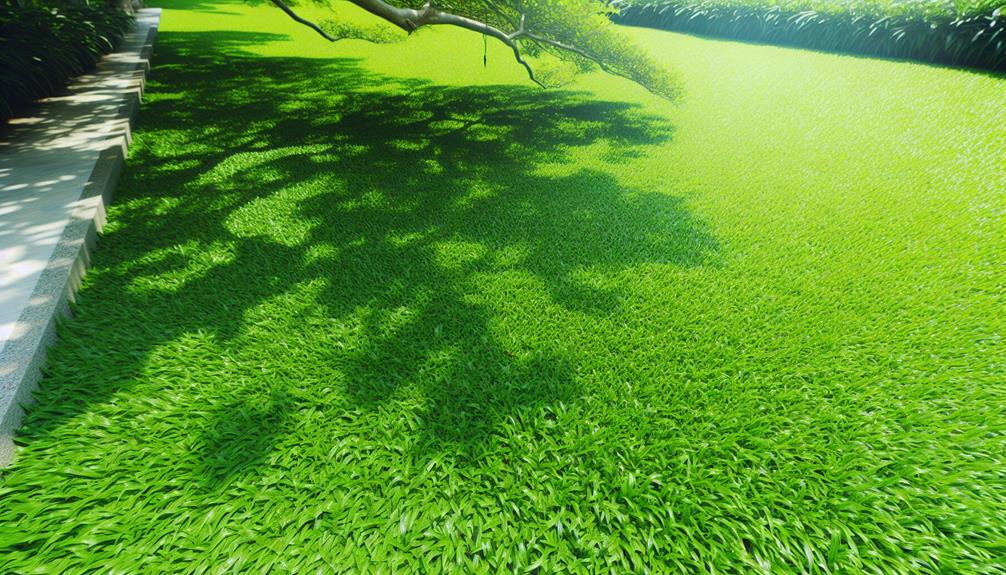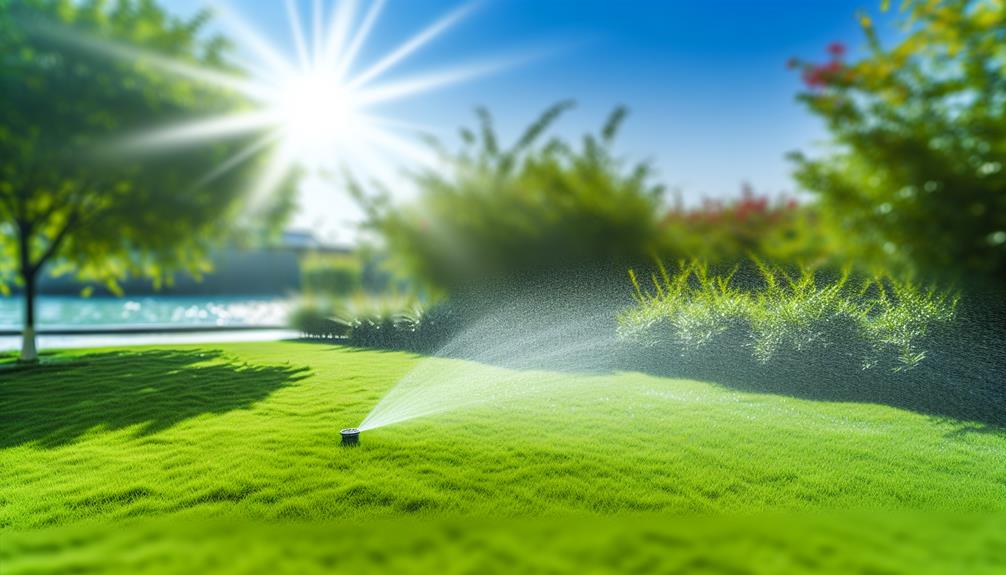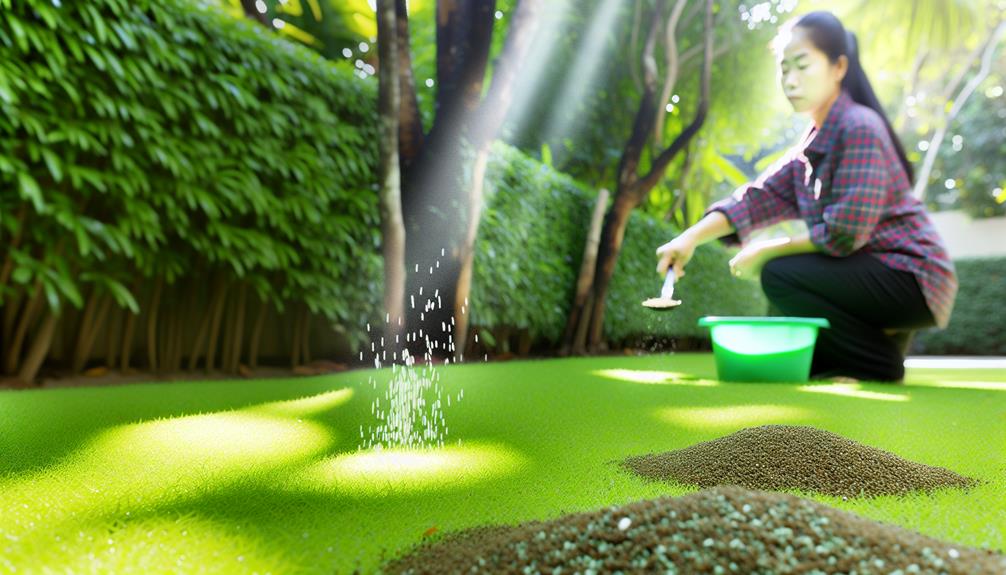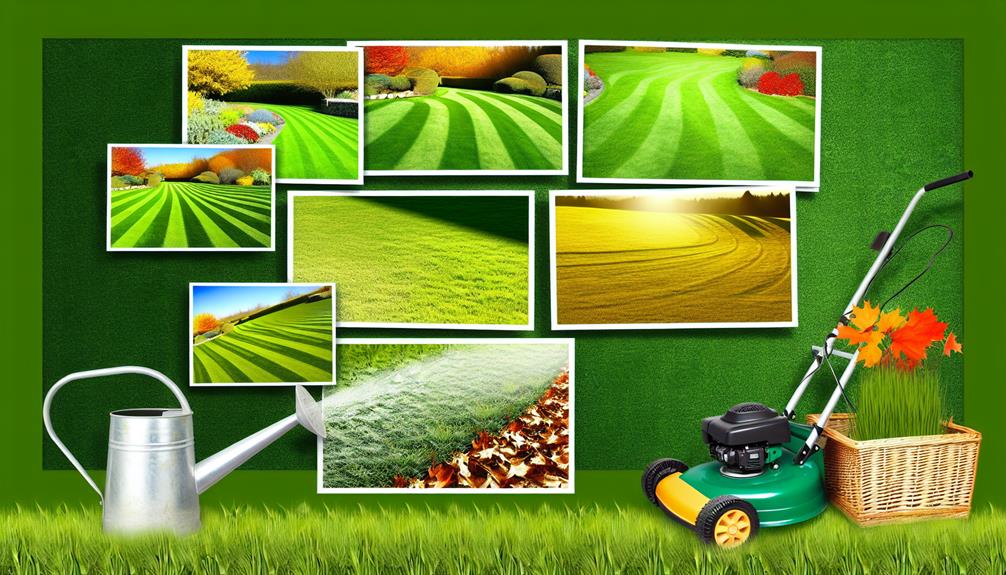Zoysia sod is an excellent option for homeowners seeking a low-maintenance lawn. Renowned for its durability, it thrives in diverse climates while requiring less mowing and watering than traditional grass types. This grass exhibits remarkable drought resistance and natural pest resilience, minimizing the need for chemical treatments. Zoysia's lush appearance enhances aesthetic appeal throughout the year. To achieve ideal growth, it needs well-draining soil and adequate sunlight, making proper installation essential. Its long-term benefits include reduced water bills and fewer fertilization needs, ensuring both convenience and cost-effectiveness. Discover the essentials of Zoysia care to enhance your lawn's health and appearance further.
Key Takeaways
- Zoysia sod requires less mowing and watering, making it an ideal choice for low-maintenance lawns.
- Its natural pest resistance minimizes the need for chemical treatments, promoting a healthier environment.
- With excellent wear tolerance, Zoysia withstands heavy foot traffic without compromising its lush appearance.
- Zoysia thrives in full sun to partial shade, ensuring a vibrant lawn year-round with minimal effort.
- Long-term savings on water bills and lawn care products result from Zoysia's drought resistance and durability.
What Is Zoysia Sod?

Zoysia sod is a type of grass that is renowned for its durability and ability to thrive in various climatic conditions, making it an ideal choice for low-maintenance lawns. This grass comes in several Zoysia varieties, each offering unique characteristics suited to different environments and preferences. Common varieties include Zoysia japonica, Zoysia tenuifolia, and Zoysia matrella, each providing excellent wear tolerance and a lush, green appearance. Additionally, choosing the right grass type can enhance your landscape's appeal, similar to how fitness sales careers can transform your professional journey.
The Zoysia benefits extend beyond aesthetics; it is known for its exceptional drought resistance and ability to outcompete weeds, reducing the need for chemical treatments. Its dense growth habit creates a robust lawn that can withstand foot traffic, making it suitable for both residential and commercial applications. Moreover, Zoysia sod's slow growth rate means less frequent mowing, appealing to those seeking to minimize their lawn maintenance efforts.
Benefits of Zoysia Grass
One of the most significant advantages of Zoysia grass is its resilience in varying environmental conditions, making it an ideal choice for homeowners and landscapers seeking a low-maintenance lawn solution. Its remarkable drought tolerance allows it to thrive even in dry spells, reducing the need for frequent watering. Additionally, Zoysia grass exhibits impressive shade adaptability, enabling it to flourish in areas that receive limited sunlight, thereby enhancing the aesthetic appeal of shaded landscapes. For those considering entrepreneurship in lawn care, discovering profitable local businesses can provide insights into the best practices for maintaining Zoysia lawns.
The benefits of Zoysia grass extend beyond its environmental resilience, creating a welcoming and vibrant outdoor space:
- Reduced maintenance requirements: Spend less time mowing and watering.
- Lush, green lawn year-round: Enjoy a beautiful lawn in every season.
- Natural pest resistance: Minimize chemical treatments for a healthier yard.
- Durability: Withstands heavy foot traffic, making it perfect for active families.
- Soil improvement: Enhances soil health over time, promoting a sustainable ecosystem.
Choosing Zoysia grass not only elevates the beauty of your property but also fosters a sense of belonging within your community, where lush, resilient lawns contribute to a shared environment of pride and enjoyment.
Ideal Growing Conditions

For ideal growth and importance, Zoysia grass thrives under specific environmental conditions that cater to its unique characteristics. Understanding these conditions is essential for homeowners seeking a low-maintenance lawn that remains vibrant and resilient throughout the seasons. Engaging in activities like group fitness classes can also promote a healthy lifestyle that complements the beauty of your lawn.
Zoysia grass has distinct sunlight requirements, flourishing best in full sun to partial shade. Ideally, it requires at least six to eight hours of direct sunlight daily to establish a dense, lush carpet. Insufficient sunlight may lead to thinning and weakened growth, undermining the aesthetic appeal and durability of your lawn.
In addition to sunlight, Zoysia has particular soil preferences that greatly impact its growth. It thrives in well-draining, sandy loam soils with a pH level ranging from 6.0 to 7.0. Ensuring ideal soil conditions not only enhances the grass's drought resistance but also minimizes susceptibility to pests and diseases. Regular soil testing can help homeowners maintain these perfect conditions.
Installation Process
The installation process of Zoysia sod is essential for establishing a robust and low-maintenance lawn. Before beginning, it's advisable to take into account local resources for group fitness classes that can help maintain your physical health while managing your lawn. This process encompasses several key steps, including thorough site preparation, precise laying of the sod, and subsequent watering and maintenance practices. Adhering to these steps guarantees peak growth and longevity of your Zoysia lawn.
Site Preparation Steps
Before laying Zoysia sod, proper site preparation is essential to guarantee successful establishment and long-term health of the lawn. This initial investment in time and effort will yield a lush, vibrant lawn that fosters a sense of belonging within your community.
Key steps in site preparation include:
- Soil Testing: Assess pH and nutrient levels to guarantee ideal growth conditions.
- Ground Leveling: Achieve a smooth and even surface to prevent water pooling and enhance aesthetic appeal.
- Weed Removal: Eliminate existing weeds to prevent competition for nutrients and resources.
- Soil Aeration: Improve soil structure and promote root penetration for robust growth.
- Fertilization: Apply a starter fertilizer to nourish the soil, guaranteeing a healthy foundation for your Zoysia sod.
Laying the Sod
Once the site preparation is complete, laying Zoysia sod becomes an important step in establishing a resilient and low-maintenance lawn. Utilizing effective sod installation techniques is essential for ensuring ideal growth and longevity of your Zoysia sod. Begin by placing the first piece along a straight edge, such as a sidewalk or driveway, to create a uniform appearance. Stagger the seams in each subsequent row to promote better interlocking, which enhances stability and reduces weed growth.
Zoysia sod advantages include its ability to thrive in various soil types and its natural resistance to pests and diseases. This makes it an excellent choice for homeowners seeking a lush lawn without the continual need for chemical treatments. As you lay the sod, press down each piece firmly to eliminate air pockets, ensuring good soil contact, which is crucial for establishing root systems.
Completing this phase with care not only enhances the aesthetic appeal of your lawn but also fosters a sense of pride and belonging within your community. By following proper installation techniques, you are investing in a sustainable, vibrant landscape that will be enjoyed for years to come.
Watering and Maintenance
Successful installation of Zoysia sod is only the beginning of cultivating a low-maintenance lawn; proper watering and ongoing maintenance are essential for ensuring the sod establishes effectively and thrives long-term. Implementing efficient irrigation techniques can greatly enhance moisture retention, making your lawn resilient to drought and reducing the need for excessive watering.
Initially, water the sod daily for the first two weeks to promote root establishment, gradually shifting to every other day for the next two weeks. After this initial period, adjust your watering schedule based on rainfall and temperature, aiming for about 1 inch of water per week.
To maximize the effectiveness of your watering routine, consider the following:
- Create a unified community of lush, green grass that everyone admires.
- Experience the satisfaction of minimal lawn care while enjoying a beautiful landscape.
- Feel the pride of a thriving lawn that requires less water than traditional grasses.
- Enjoy more leisure time, free from constant lawn maintenance.
- Foster a welcoming environment for family and friends to gather and create memories.
Watering Requirements

Effective management of watering requirements is vital for establishing and maintaining a healthy Zoysia sod lawn. Zoysia grass exhibits remarkable drought tolerance, making it an ideal choice for homeowners seeking a low-maintenance solution. Additionally, with the global shift towards sustainable landscaping practices in 2024, key trends in irrigation can help optimize water usage. However, proper irrigation techniques during the establishment phase are important to guarantee robust root development.
Initially, Zoysia sod should receive ample water to promote deep rooting. A general guideline is to irrigate lightly daily for the first two weeks, gradually evolving to deeper, less frequent watering. This approach encourages roots to grow downwards, enhancing the lawn's resilience to dry conditions.
Once established, Zoysia thrives on about one inch of water per week, which can be delivered through efficient irrigation techniques, such as drip systems or soaker hoses. These methods minimize water waste while guaranteeing the turf receives adequate moisture. It is vital to monitor rainfall and adjust your irrigation schedule accordingly, avoiding overwatering, which can lead to fungal diseases.
Mowing Guidelines
Proper irrigation practices set the stage for excellent lawn care, including mowing, which plays a significant role in the health of Zoysia sod. To maintain a lush, vibrant lawn, it is crucial to adhere to specific mowing guidelines that promote its well-being.
- Maintain the ideal mowing height: Keep Zoysia grass at a height of 1 to 2 inches. This height encourages deeper root growth and enhances drought resistance.
- Establish a consistent mowing frequency: Mow every 1 to 2 weeks during the growing season to avoid scalping and to promote healthy growth.
- Mow when the grass is dry: This prevents clumping and guarantees a clean cut, resulting in a healthier lawn.
- Utilize sharp mower blades: Dull blades can tear the grass, leading to stress and disease, while sharp blades provide a clean cut.
- Change mowing patterns: Altering your mowing direction each time can prevent soil compaction and promote an even growth pattern.
Fertilization Tips

Proper fertilization is vital for maintaining the health and appearance of Zoysia sod. To achieve peak growth, it is imperative to understand the best timing for fertilization, select appropriate fertilizer types, and employ effective application techniques. By following these guidelines, homeowners can guarantee a lush, vibrant lawn while minimizing maintenance efforts.
Optimal Timing for Fertilization
Timing is essential when it comes to fertilizing zoysia sod, as applying nutrients at the right moment can greatly enhance lawn health and growth. Ideal fertilizer timing guarantees maximum nutrient absorption, allowing your lawn to thrive. For zoysia, the best times to fertilize are in late spring and early summer, coinciding with the grass's active growing season.
Consider these key points when determining your fertilization schedule:
- Spring Awakening: Stimulate growth as the sod emerges from dormancy.
- Peak Performance: Support lush development during the warmest months.
- Soil Testing: Tailor fertilizer applications based on nutrient needs.
- Watering Regimen: Guarantee proper moisture for effective nutrient uptake.
- Seasonal Observations: Monitor grass color and growth to adjust timing.
Recommended Fertilizer Types
Selecting the right type of fertilizer is essential for the health and vigor of zoysia sod. To achieve ideal growth and resilience, consider using organic fertilizers, which enrich the soil with essential nutrients while promoting a sustainable ecosystem. Organic options not only improve soil structure but also enhance microbial activity, leading to a more robust lawn.
Among the various choices, slow release options stand out as particularly beneficial for zoysia sod. These fertilizers gradually supply nutrients over an extended period, reducing the risk of nutrient leaching and ensuring consistent nourishment. This steady release is advantageous for zoysia, which thrives on a balanced nutrient supply throughout its growing season.
When selecting a fertilizer, look for formulations rich in nitrogen, phosphorus, and potassium, with a balanced N-P-K ratio tailored to the specific needs of zoysia. Engaging with local garden centers or lawn care professionals can help you identify the best products available in your region. By choosing the right fertilizer, you not only cultivate a thriving zoysia lawn but also foster a sense of community among fellow lawn enthusiasts, sharing the joy of a lush, low-maintenance landscape.
Application Techniques and Tips
How can you guarantee that your zoysia sod receives ideal nourishment during its essential growth phases? Effective fertilization is key to thriving zoysia grass, ensuring it flourishes in your yard. Begin by implementing appropriate sod installation techniques, which set the foundation for successful growth. Follow these zoysia care tips to optimize your fertilization efforts:
- Select the right fertilizer: Use a slow-release nitrogen fertilizer, ideally formulated for warm-season grasses.
- Timing is vital: Fertilize in late spring or early summer when the grass is actively growing.
- Application methods: Utilize a broadcast spreader to achieve even distribution, avoiding clumps that can damage the grass.
- Water after fertilization: Lightly irrigate the area post-application to help nutrients penetrate the soil and reach the roots.
- Monitor growth: Regularly assess your lawn's health and adjust your fertilization schedule based on its needs.
Pest and Disease Resistance
Zoysia sod consistently demonstrates remarkable resistance to common pests and diseases, making it an excellent choice for homeowners seeking a low-maintenance lawn solution. This resilience not only minimizes the need for extensive pest management but also promotes effective disease prevention, allowing homeowners to enjoy a lush, healthy lawn with minimal effort.
One of the standout features of Zoysia grass is its ability to withstand threats such as grubs, chinch bugs, and various fungal diseases. This natural resistance considerably reduces the necessity for chemical treatments, fostering a more environmentally friendly lawn care approach. Additionally, Zoysia's thick growth habit and deep root system create a robust turf that can outcompete weeds, further enhancing its durability.
For homeowners who value both aesthetics and practicality, Zoysia sod offers a compelling option. By investing in this resilient grass, you not only create a beautiful outdoor space but also join a community of like-minded individuals who prioritize sustainable, low-maintenance landscaping. To sum up, Zoysia sod's inherent pest and disease resistance positions it as a premier choice for those seeking a thriving, stress-free lawn.
Seasonal Care Strategies

Effective seasonal care strategies are essential for maintaining the health and appearance of Zoysia sod throughout the year. In spring, proper fertilization will stimulate robust growth, while summer demands a specific watering regimen to guarantee ideal moisture levels. Finally, implementing thoughtful maintenance practices in the fall will prepare the lawn for dormancy and promote resilience against winter conditions.
Spring Fertilization Tips
As spring arrives, it's crucial to kick off the growing season with an appropriate fertilization strategy for your zoysia lawn. This is the time to verify your spring soil is primed for ideal nutrient absorption, setting the stage for a lush, green landscape that fosters community pride and enjoyment.
Follow these essential spring fertilization tips to maximize your lawn's potential:
- Choose a slow-release fertilizer to provide consistent nutrients over time.
- Test your soil to determine pH levels and specific nutrient needs.
- Apply fertilizer when the grass is actively growing, usually late spring.
- Water your lawn lightly after fertilization to help nutrients penetrate the soil.
- Avoid over-fertilization, which can lead to a weaker lawn and environmental harm.
Summer Watering Guidelines
Maintaining a healthy zoysia lawn during the summer months requires a strategic approach to watering, as this grass type thrives in warm weather but can suffer from drought stress. To combat the challenges posed by summer drought, it is crucial to implement effective irrigation techniques that guarantee your lawn receives adequate moisture without excessive waste.
Begin by establishing a regular watering schedule, aiming for approximately 1 inch of water per week, including rainfall. Early morning is the prime time for irrigation, as it minimizes evaporation losses and allows the grass to absorb moisture before the heat of the day. Adjust your watering frequency based on rainfall and temperature, recognizing that zoysia is drought-tolerant but still benefits from consistent moisture.
Consider utilizing drip irrigation or soaker hoses to deliver water directly to the root zone, enhancing efficiency and reducing water runoff. Additionally, applying a layer of mulch can help retain soil moisture and regulate temperature. By adopting these irrigation techniques, you will not only maintain a lush zoysia lawn but also foster a sense of community pride in your low-maintenance outdoor space.
Fall Maintenance Practices
Zoysia lawns require careful attention during the fall months to secure ideal health and resilience heading into winter. Proper fall maintenance practices not only enhance the appearance of your lawn but also assure its longevity. The following strategies are essential for a thriving zoysia lawn:
- Conduct a thorough fall cleanup to remove debris and dead grass.
- Implement effective leaf management to prevent suffocation of the grass.
- Schedule lawn aeration to improve soil oxygen and nutrient absorption.
- Prioritize weed control to minimize competition for resources.
- Perform soil testing to tailor winter preparations according to nutrient needs.
These practices foster a healthy, vibrant lawn that invites you and your family to enjoy outdoor activities together. By committing to these fall maintenance strategies, you create a welcoming environment that enhances your home's curb appeal and promotes a sense of belonging within your community. As the seasons change, investing time in your zoysia lawn will pay off in the form of a lush, resilient landscape that endures the challenges of winter, setting the stage for a flourishing lawn come spring.
Cost Considerations
When evaluating the cost considerations of installing zoysia sod, homeowners should account for both initial expenses and long-term maintenance costs. Zoysia pricing typically ranges from $0.50 to $1.50 per square foot, depending on the variety and supplier. While the upfront investment may be higher compared to traditional grass types, the benefits of zoysia sod justify this expenditure.
Zoysia grass is known for its resilience and drought tolerance, which translates to reduced watering and fertilization needs. This characteristic leads to significant long-term savings over the life of the lawn. Homeowners can expect to spend less on water bills and lawn care products, making zoysia a financially sound choice. Additionally, zoysia's natural resistance to pests and diseases minimizes the need for chemical treatments, further decreasing maintenance costs.
Incorporating zoysia sod into your landscape not only enhances the aesthetic value of your home but also fosters a sense of community pride. With careful consideration of zoysia pricing and the potential for long-term savings, homeowners can confidently invest in a sustainable and beautiful lawn that will serve their families for generations.
Frequently Asked Questions
How Long Does It Take for Zoysia Sod to Establish?
The establishment period for zoysia sod typically ranges from two to three months, depending on environmental conditions and care provided post-installation. During this time, root development is essential, as it influences the sod's long-term viability and resilience. Proper watering, fertilization, and minimal foot traffic will aid in accelerating this process. Investing in quality sod installation will guarantee a robust lawn that fosters a sense of community and pride among homeowners.
Can Zoysia Sod Survive in Shaded Areas?
Zoysia sod exhibits notable shade tolerance, allowing it to thrive in partially shaded areas. However, its growth patterns indicate that while it can survive under such conditions, ideal health and vigor are achieved in full sun. In shaded environments, zoysia may grow more slowly, necessitating careful management and occasional supplemental light. For those seeking a resilient lawn solution, understanding these dynamics is essential in maximizing zoysia's aesthetic and functional benefits.
Is Zoysia Grass Suitable for High-Traffic Yards?
Zoysia grass exhibits high traffic durability, making it an ideal choice for yards that endure frequent use. Its dense growth habit helps withstand foot traffic, reducing wear and tear. Additionally, zoysia requires moderate maintenance, with periodic mowing and watering, fostering a resilient lawn that balances beauty and functionality. Homeowners seeking a robust solution for active outdoor spaces will find zoysia grass an exceptional option, enhancing both the aesthetic appeal and usability of their landscapes.
How Do I Know if My Zoysia Sod Is Healthy?
To assess the health of your zoysia sod, examine its characteristics closely. Healthy zoysia grass displays a vibrant green color, dense growth, and minimal weed presence. Regular maintenance should include appropriate watering and mowing practices to promote robust root development. Additionally, check for uniformity in texture and resistance to pests. If your zoysia exhibits these qualities, it is likely thriving, providing a resilient and attractive lawn that requires less upkeep.
Can I Overseed Zoysia Grass With Other Types of Grass?
Overseeding zoysia grass with other types of grass can be challenging due to its growth characteristics. However, employing effective overseeding techniques can enhance lawn density and resilience. Compatible grasses such as ryegrass or fescue may be considered, as they can thrive alongside zoysia during cooler months. Careful selection and timing are vital to guarantee successful integration, promoting a lush, green lawn that fosters a sense of belonging within your outdoor space.

